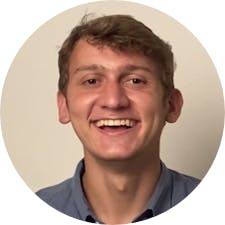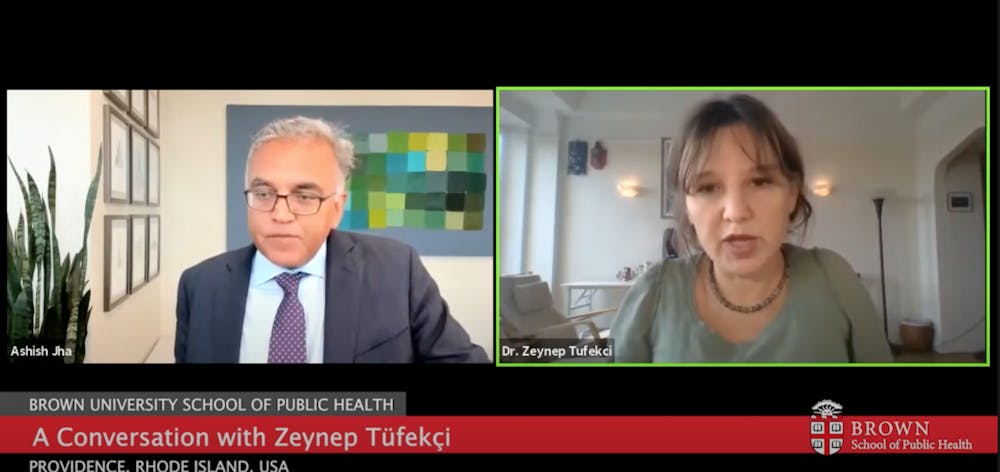Dr. Zeynep Tufekci, a sociologist who emerged as one of academia’s most prominent voices during the COVID-19 pandemic, joined Dr. Ashish Jha, dean of the University’s School of Public Health, in a virtual conversation Wednesday afternoon.
The two come from differing academic backgrounds: Jha is a physician and public health scholar by training, while Tufekci is a professor at the University of North Carolina at Chapel Hill focused on technology, society and “systems thinking,” the connection of multiple academic disciplines. But both have played predominant roles in explaining COVID-19 to the public, with Jha bouncing from one news network to another and Tufekci penning influential op-eds and articles in the New York Times and the Atlantic. Both have also been constant presences on Twitter, sharing insights on vaccines, masks and aerosol transmission, sometimes even conversing with each other online.
Their differing perspectives, combined with their shared experience explaining the pandemic, were a key subject of Wednesday’s event. The two discussed the failures of communication that have plagued public health institutions, the “dogma” that scientists refused to give up and why interdisciplinary scholars may have had a better angle on COVID-19 all along.
Tufekci’s advantage began in early 2020, Jha said — when she was among the first academics to seriously gauge the severity of what was ahead, along with being among the first advocates for mask-wearing.
Her knowledge of authoritarian systems and study of near-misses like SARS helped her contextualize the severity of COVID-19 early on, Tufekci said. While “not an anxious person by nature,” the sequence of events — reports of an unknown pneumonia in China, evidence of human-to-human transmission, the shutdown of the Hubei province and evidence of asymptomatic transmission — convinced her that a pandemic was coming.
She then lived through an “out-of-body” experience for a month: filling her prescriptions, stockpiling masks and warning the public, only for her words to fall upon deaf ears. In February, she wrote an article for Scientific American laying out her predictions and linking to a list of precautions that people could take, including mask-wearing — an article that she hoped would convince her academic friends to cancel conferences they had planned for April. The scientific community, she said, pushed back hard, especially on the notions that asymptomatic civilians should wear masks.
“I remembered thinking, what am I missing?” Tufekci said on Wednesday, adding that the reasons listed for not wearing masks at the time were “bunk.”
“I thought, any moment (now), some big name is going to write an op-ed telling us to come to our senses.”
The CDC and other health authorities confirmed Tufekci’s intuition when they called upon Americans to wear masks during everyday activities months later.
Her knack for correct predictions and intuitions, Jha said, comes from her unique lens on public health.
“This was … about connecting dots from deeply disparate fields, from understanding authoritarians to understanding information flow, systems thinking about near-misses and preventing catastrophic events,” he said. Academia, he added, “disincentivizes … dot-connecting,” instead encouraging experts to stay siloed in one corner of research.
An interdisciplinary model of research works particularly well in pandemics, which Tufekci called a “society-wide question.” But Tufekci and Jha emphasized the difference between the idea of an “armchair epidemiologist” — someone who only relies on outside expertise to, for example, model out the pandemic’s course — and scholars who break from their expertise while putting in work to expand their horizons. The work for Tufekci meant reading 100 academic papers for an article she wrote about aerosol transmission of COVID-19.
“This lane-swerving works to the degree that you’re willing to put in the legwork,” Tufekci said. “I check it with people. I have tons of conversations to say, what am I missing?”
At one point, Tufekci said, she offered what equated to a ransom on her own articles, offering money to anyone who could disprove her arguments.
“I don’t want the finance guy who has never read an infectious disease paper to come lecture,” she added. “But I don’t want anyone who didn’t get the right PhD to be shut out.”
Gatekeeping qualified outsiders and elevating scientific dogma above the scientific method, Jha and Tufekci said, has limited sensible policy choices about issue like virus transmission.
“The science of how this virus spreads has been extremely clear,” Jha said, explaining that while airborne spread appears to be a key driver of transmission, “droplets and surfaces” still dominate much of the conversation.
“There’s no other framework that can explain the world (pandemic),” Tufekci added, noting with dismay that the World Health Organization still won’t use the word “airborne.”
The same deference to existing science, she said, likely cost hundreds of thousands of lives during the vaccine rollout. Had countries delayed the second dose of COVID-19 vaccines, she said, there would have been enough supply that the entire global population over 50 could have accessed a first dose, saving lives and potentially even preventing the proliferation of the Delta variant.
Jha agreed, adding that when he and others called for implementing the first dose model, used by Canada and a number of other countries, they were called “anti-science.”
Part of this, the pair agreed, had to do with a genuine anti-science movement proliferating in the United States and globally, charged by the political right. That threat to science, Tufekci said, likely led others to feel the need to defend science. But science, Jha noted, “does not care if you go to bat for it.”
The pandemic, the pair agreed, also represented a significant failure of communication on behalf of the government — leaving people like them to fill the gaps. In an ideal world, Tufekci said, a trusted figure would speak to the press twice a week, covering every conceivable base and synthesizing the news. And institutions, they said, have also floundered, such as state and federal agencies issuing confusing guidelines on booster shots and failing to consider the most pressing needs first — such as whether or not Johnson & Johnson vaccine recipients need a booster.
“They’re not geared for public health; they’re geared for medical stuff,” Tufekci said. “It’s kind of crazy to me that there’s no authority that says, ‘what are we doing here?’”
The pandemic, Jha said, is a public health and societal crisis, but institutions have responded to it as a medical crisis.
“This was a stress test for a lot of our institutions,” Tufekci said. “And our institutions are not fine.”

Will Kubzansky is the 133rd editor-in-chief and president of the Brown Daily Herald. Previously, he served as a University News editor overseeing the admission & financial aid and staff & student labor beats. In his free time, he plays the guitar and soccer — both poorly.




